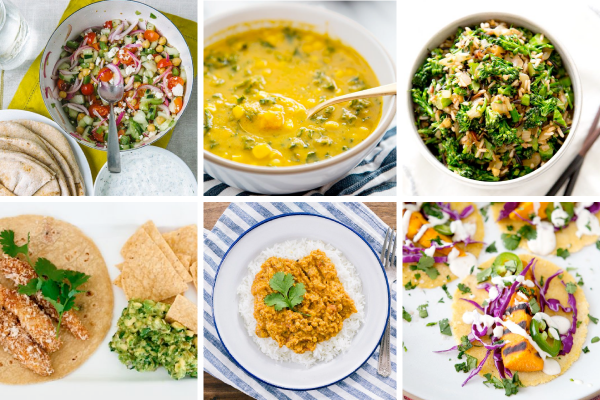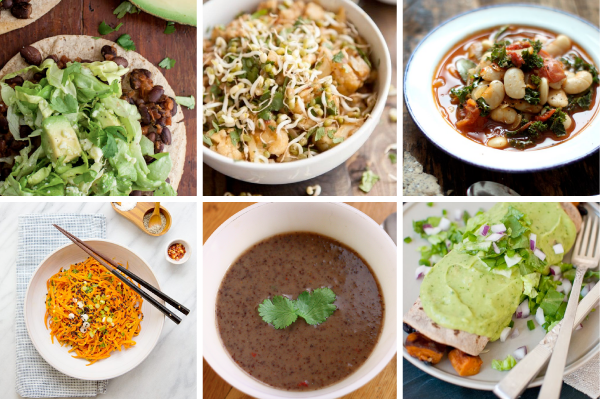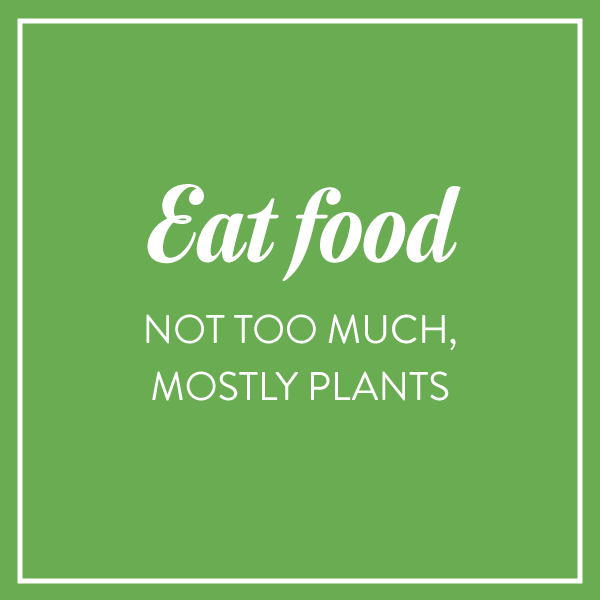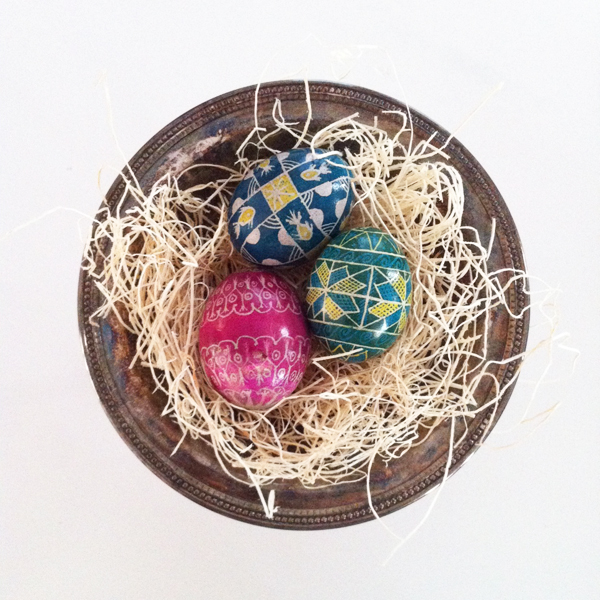28 April 2014
Friends, thank you for your thoughts on part one! I heard from a few of you in the comments and in person that it sparked conversation, and I love that – not only because now you’re in the same boat as me (ha!) but because I think what we eat is a worthwhile thing to think and talk about. So let’s continue!
One thing that frustrated me about Forks Over Knives is that it included very little practical information – like, what a FOK-approved meal might look like. This post will be my attempt to fill in the gaps, at least relative to our life.
Let’s start with a few resources we’ve found helpful. Some of our favorite clean and whole recipes have come from A Couple Cooks, Naturally Ella, and A House in the Hills. We also like Pinch of Yum and Cookie + Katie. Since we’re looking for recipes that can be made for dinner on a regular weeknight when we get home from work, we need them to be both realistic and delicious, and these folks have come through time and again.
To get even more specific, I’ve sprinkled twelve of our favorite recipes throughout this post. More recipes we’ve liked are here, and recipes we have our eye on are here!

Greek pita sandwiches; sweet potato, kale, and corn chowder; broccolini fried rice; panko crusted fish tacos, spiced red lentils and rice, grilled sweet potato tacos with lime crema
There are a few foods we’ve had in heavy rotation during this transition. Number one is sweet potatoes. In addition to being really good for you, they are one of the best substitutes for meat in that they’re substantial, filling, and can take on lots of different flavors. They also take a long time to go bad, are inexpensive, and taste about the same year round. We eat them a LOT.
Almost every night we eat a salad with spinach, arugula, and sometimes kale. We often add cashews, pumpkin seeds, and sometimes cheese (feta for John, goat for me). I love our dressing – a basic vinaigrette we make (3 Tbs. olive oil, 2 Tbs. red wine vinegar, and 1 Tbs. mustard – shake it/store it in a mason jar).
We’ve cut out a LOT of pasta at home, substituting brown rice noodles, homemade vegetable noodles (just ribboning carrots, sweet potatoes, or zucchini with a peeler), or brown rice.
We’ve also switched or added a few specific products:
— Tropicana OJ has been replaced by the Whole Foods 365 brand 100% Florida orange juice thanks to this article.
— Coconut oil often replaces butter (though not always).
— John’s twice daily Coke Zeros are now Honest Fizz root beer, a can of Steaz, or water.
— The only ingredients in our peanut butter are now peanuts and salt.
— I’ve switched to KIND granola bars as a snack.
— I do drink some whole or 2% milk; it now comes from a farm in the next county over – the same one where we go for ice cream (I’ve even taken a tour!). It’s available at our Whole Foods.
We definitely have more changes we’d like to make (for example, I often eat buckwheat waffles or granola for breakfast, and I’d like to start making both myself), but it’s a process.
Also, just as a reminder, we are still eating sugary and processed things on occasion! Our belief is that if we feed our bodies a regular diet of the good stuff, it can (sparingly) handle the bad stuff. Because sometimes the bad stuff is delicious :)

Black bean tostadas with avocado salad; spicy peanut sauce with brown rice noodles; garlicky kale and white bean stew; carrot noodles in peanut sauce; black bean soup with cumin and jalapeno; sweet potato burritos with avocado salsa verde
One question Whitley asked on my last post that I wanted to address was this: “I think one of the things that scares me most about “clean” eating is the perception that it’s more expensive. Have you found this to be true?”
I’m glad she asked, because I have a few thoughts about this! First, though the amount of our food budget has not changed dramatically in this transition, I would not have been surprised or particularly upset if it had. For other things I care about, I expect to pay more for quality, so naturally, I wouldn’t be surprised if better food cost more. In the long term, when taking quality of life and healthcare into account, I expect it to be far less expensive than other ways of eating.
Michael Pollan also points out in The Omnivore’s Dilemma that the percentage of the average household budget allocated for food has steadily decreased over the past few decades, at the same time as food has generally gotten less nutritious. We’ve become accustomed to getting more for less, but in order to pay for the things I care about (happy animals, sustainable and Earth-friendly farming practices), I am willing to pay more (and readjust/make room in my budget accordingly).
As someone who truly believes in the power of free market forces, I believe that we are casting a vote with every beep of the supermarket scanner. With my dollars and my choices, I can tell Whole Foods and Walmart and every brand they stock what I want to see more of. The thought almost makes me giddy! :)
However, even though important, I know that’s probably not what Whitley meant, and so I’ll answer the other way, too. Our biggest expense has always been and still is wasting food – letting meat go bad before putting it in the freezer or using it, leaving lettuce to wilt, or buying a jar of something and only using a teaspoon before it expires. Sticking to a weekly meal plan greatly helps with this, as does regularly taking stock of our pantry and refrigerator – and keeping both neat and organized so that things don’t get shoved to the back and forgotten.
Second, though we do about half of our shopping at Whole Foods (most of our vegetables, and packaged food we can’t find elsewhere) the rest is done at Walmart. We’ve found that many (though hardly all) brands we could buy at WF are available at Walmart for less, including Stonyfield, Annie’s, and Kind. We also tend to buy bananas and root vegetables like garlic, potatoes, and onions at Walmart because the quality is comparable (unlike more perishable things like fruit or tomatoes). So, being smart about where we buy helps keep our costs down. The 365 brand at Whole Foods also offers some great savings.
It’s not new advice, but things tend to taste better and cost less when you buy them in season and, if possible, when you pick them yourself. Berries, of course, are the perfect example – we love picking strawberries in the spring and blueberries in the summer, both of which we can do ten minutes from our house.
Since we only eat meat about once a week now, we can afford to buy happy animals and still have some savings left over to soak up other new expenses. Depending on what your current diet is, some of those expenses might be new oils, spices, or other ingredients you haven’t used before (like coconut oil and tamari for us!).
To finish, I wanted to note that one thing we are excited to explore more is buying local. The pastoral section of The Omnivore’s Dilemma really inspired me on this point, with its description of Joel Salatin’s farm (which some of you might remember from Food Inc.). A few weeks ago we bought a chicken at our town’s farmer’s market that had hatched, was grown, and then processed the day before about ten minutes from our house. We bought it from the person who did it. Joel suggests this site and this site for finding other local sources for sustainably raised food (in addition to farmer’s markets!).
Whew! I’m glad we’re at the end of this post, because now it’s your turn: I would love to hear your go-to resources and recipes for clean, whole, and easy recipes! Thank you in advance :)
23 April 2014
I haven’t written about food a lot here because in general, it’s not something I think about too much. In general, it’s not something I’m preoccupied by – it never has been, and I hope it never will be.
But recently, thoughts about what we eat have been driving me nearly to distraction – so much so that a few weeks ago I had to sit down and type out my thoughts simply to quiet my mind. (It helped.) Since that point, John and I have come to some conclusions and made some changes. I know our actions and thoughts will continue to evolve over time, so I wanted to take a moment to record where we are now.
The thing that kicked off this food frenzy was a family viewing of Forks over Knives, a documentary that argues that most, if not all, degenerative diseases can be controlled or reversed by rejecting the dominant American diet of animal based and processed foods. While we had some issues with some of the studies they cite, the basic premise seems sound — and most importantly, makes logical sense to me.
John was immediately on board to cut dairy, meat, and sugar from our diet completely. To be honest, that scared me. The diet described in Forks over Knives sounded like complete and total drudgery, and I didn’t want every meal to become something I forced into my mouth. I didn’t want to live by rigid rules, inconveniencing every host and never being able to eat at a restaurant.
I do think our diet at the beginning of this year was better than average. Since graduating from college we’ve been on a slow and steady progression toward fewer processed foods, less meat, and more plants. You may remember that one of my daily goals for 2013 was to eat at least one “super food” a day, which has proven to be a great way to regularly get really good foods on my plate.
But back to the present: as my mind raced with all of the information from Forks over Knives and our subsequent conversations, I searched for more information to help us make informed decisions. Michael Pollan popped up over and over again, so I checked The Omnivore’s Dilemma out of the library.
Let me tell you, I really appreciate Michael Pollan.

He’s so calm and reasonable, which I feel are two qualities greatly lacking from a national conversation that celebrates something one week and then denounces it the next. In case you’re not familiar with him, Pollan’s advice has been famously boiled down to this: eat food — not too much, mostly plants.
Yes! We want this to be a long term life change, and in the long term, moderation works for us. Quitting things cold turkey or labeling certain things off limits does not. That being said, we don’t intend to use moderation as an excuse. Like the Forks over Knives peeps, we do believe that the diet we eat has a direct and strong effect on our bodies’ ability to stay healthy. We also believe that our body is equipped to process things that aren’t necessarily beneficial (like sugar), but that in order for it to be able to do that, we need to keep it in tip top shape and reduce the amount of “bad” things we take in overall.
So what does that mean for us? As I was searching for recipes to fit our new diet, I came across the A Couple Cooks blog. Their description of what they eat fits so perfectly with how we feel that I have to quote from it liberally here:

Our diet? We call it flexitarian. It’s mostly vegetarian, but with the freedom to enjoy all food. In general, we avoid purchasing “processed” foods — frozen meals, fast food, unhealthy snacks, items with mystery ingredients or added sugars. But overall, we like to focus on what we do eat instead of what we don’t.
— We try to eat the foods that have the most benefits to us and to our community.
— We find the approach of a “Mediterranean” style diet to make good sense: lots of fruits, vegetables, whole grains, and healthy fats, but without trying too hard to fit within a certain marketable mold.
— There are a lot of diets out there. As a common core, we see homemade whole foods as the key that ties any healthy diet together.
— We eat mostly vegetarian because of the relatively lower resources (environmental and financial) required to put veggies on our table, but we also support the meat-raising farmers in our community on occasion.
— We buy organically-grown items when we can handle the price, to support the farmers who put in the extra effort of taking care of our farmland.
— We’ve found that an all-in-moderation approach works well for us. When we make pizza, we use white flour, because we like it that way. While we generally cook meatless, I recently enjoyed a big juicy steak to initiate the grilling season. In general, we choose to enjoy healthy and colorful salads, nourishing soups, and fresh veggies as our daily meals.
This diet works for us. It is freeing, and we find a lot of joy in it.
Yes, yes, yes!! Remember how my initial thought was that I didn’t want every meal to be drudgery? Sonja and Alex are correct – eating like this can be joyful, and we have found it to be so. Even in the last two months (February to March, not exactly the height of the growing season), we have found so many delicious and nutritious answers to the question of what’s for dinner.
I feel like this post is a little long on philosophy and short on details, but it’s already so lengthy that I’ve decided to split it up: the second part will go into more detail about specific recipes we’ve loved, resources we’ve found helpful, foods we’re eating more of, foods we’re eating less of, and some specific swaps we’ve made in our normal routine.
In the meantime, I’d be curious to hear: does your diet fit in a “marketable mold”? How would you describe it?
18 April 2014
For as long as I can remember, Easter in our house did not mean Easter baskets (we didn’t get them, much to our dismay at the time – but we did do a jelly bean hunt in the living room). More than the jelly beans, though, Easter meant pysanky eggs from Bingie, our mom’s mom.

A pysanka is a traditional Ukrainian Easter egg, decorated with folk designs written in beeswax. From my birth until a few years ago, my grandmother painstakingly made all of her grandchildren a new design each year, and we loved to look at our collection when we took them out of their crates in the spring. Each egg was marked with our name or initials, her initials, and the year. She also made them for special friends on occasion, and over time, they became one of her claims to fame in her small town.

At her memorial service last year, her pastor compared her to one of her eggs – beautiful and complicated, full of history and stories, and sometimes volatile. (The eggs, which are not blown out, have been known to explode!) My grandmother was a deeply layered person, and not always easy to understand. But so many of the things that define me were passed down from her – my love of garden bouquets, boat rides, singing in church, and books; a belief in thank you notes, penmanship, and family china; and the importance of standing up for the flag at parades and giving to your alma mater. I am glad I have something tangible and so beautiful to remember her by, especially at Easter.

The worst thing is never the last thing, friends. Wishing you a joyful weekend!
8 April 2014
Charleston is really a place like no other. There are so many delicious restaurants, so many pieces of history, so many cobblestone streets and colorful houses and charming courtyards within just a few square blocks… it’s almost not fair. This was our first chance to return since our weeklong vacation a few years back, and there was still plenty to experience and explore. We rented bikes for the first time and rode them all over downtown and even out onto Folly Beach at sunset (one of our favorite memories from the weekend – magical!). We also tried a few new-to-us restaurants, including Husk, Poogan’s Porch, Xiao Bao Biscuit, Hominy Grill, and Sugar Bakeshop, and we’d recommend them all! The biscuits at Poogan’s Porch were amazing. Where we stayed was decidedly less buzzworthy – the Holiday Inn Express on the edge of downtown :) But, it was nice enough, convenient, and the budget liked the price, and if that means we can take weekend trips more often, I’m all for it!
Just a few of our favorite spots and snaps from the weekend…


























































